Welcome to the world of the Greater Roadrunner, a bird that defies expectations and thrives in the rugged landscapes of the Sonoran Desert. Did you know that this remarkable bird has captured the interest of many with its incredible speed and unique adaptations? The Greater Roadrunner is not just an ordinary bird—it is a master of survival and a testament to the wonders of nature. From its diverse diet to its fascinating behaviors, join us as we explore the incredible world of the Greater Roadrunner and learn why its conservation is vital for the future. But first, let’s dive into some surprising facts about this remarkable bird…
Basic Description of the Greater Roadrunner
The Greater Roadrunner is a remarkable bird found in the Sonoran desert and other arid regions of the Southwest. This iconic bird is known for its striking appearance and unique adaptations, making it a fascinating subject of study. Let’s explore the physical characteristics and features that make the Greater Roadrunner truly captivating.
| Physical Characteristics | Features |
|---|---|
| Mottled Plumage | The Greater Roadrunner has mottled plumage that blends seamlessly with the dusty shrubs of its habitat, providing excellent camouflage. |
| Blue-Black Crest | With its bushy blue-black crest, the Greater Roadrunner stands out as a distinctive bird, adding to its allure and visual appeal. |
| Long Tail | Roadrunners possess long tails that serve as both a stabilizer and a rudder while running, allowing them to maneuver with agility and precision. |
Moreover, the Greater Roadrunner can reach an impressive length of two feet from its sturdy bill to its white tail tip. This notable size contributes to its commanding presence and enhances its ability to navigate its environment efficiently. Additionally, the Greater Roadrunner has recently expanded its range beyond the Southwest into states such as Missouri and Louisiana, demonstrating its adaptive nature and resilience.
Habitat and Range of the Greater Roadrunner
The Greater Roadrunner is well adapted to its habitat in the Sonoran desert and can be found throughout the Southwest. This bird prefers semi-open, scrubby habitats such as arid grasslands and low deserts, where it can blend seamlessly with its surroundings.
While exploring the Sonoran desert, keep an eye out for roadrunners on quiet roads in open country. These curious birds often dart out of shrub cover or across a road, providing observers with thrilling sightings of their unique behavior.
Roadrunners are also commonly found in areas dominated by creosote, mesquite, chaparral, and tamarisk. In higher elevations, they can be spotted in pinyon-juniper woodlands and cholla grasslands. Their ability to adapt to different environments is truly impressive, making them a remarkable species to study and appreciate.
To further understand the habitat and range of the Greater Roadrunner, here is a table summarizing their preferred habitats:
| Habitat | Description |
|---|---|
| Arid grasslands | Semi-open habitats with dry, grassy vegetation |
| Low deserts | Sparse, arid areas with low-growing vegetation |
| Quiet roads | Open roadways in rural areas, often surrounded by shrubs and low vegetation |
| Open country | Wide, expansive landscapes with scattered vegetation and minimal human development |

This image showcases the vast and picturesque Sonoran desert, where the Greater Roadrunner thrives. The desert landscape is rich in arid grasslands, low deserts, quiet roads, and open country – perfect habitats for these agile and elusive birds.
Diet of the Greater Roadrunner
The Greater Roadrunner is a versatile eater and predominantly feeds on animals. It will consume almost anything it can catch, including small mammals, reptiles, frogs, toads, insects, centipedes, scorpions, and birds. Roadrunners have also been observed eating carrion and preying on bird eggs and chicks. In winter, they will incorporate fruits, seeds, and other plant material into their diet. It’s worth noting that roadrunners are known to eat venomous prey, such as venomous lizards and scorpions, without any ill effect.
Prey and Diet
The Greater Roadrunner has a diverse diet and is an opportunistic hunter. It preys on various small animals, including lizards, snakes, mice, birds, and insects. Roadrunners are capable of catching fast-moving prey due to their exceptional speed and agility. They are known to chase down lizards and snakes, and they can also leap into the air to catch birds mid-flight.
Adaptations for Capturing Prey
The Greater Roadrunner has several adaptations that aid in capturing and consuming its prey. It has sharp beaks and strong jaws that allow it to tear into its food. The bird’s long legs and agile body enable it to quickly maneuver and catch fast-moving prey. Additionally, its sharp eyesight and keen sense of hearing help it locate and track its targets.
| Prey | Description |
|---|---|
| Lizards | Greater roadrunners have a particular affinity for lizards and can efficiently capture and consume them. |
| Snakes | Roadrunners have the ability to overpower and consume small snakes, including venomous species. |
| Mice | Small mammals like mice make up a significant portion of the roadrunner’s diet. |
| Birds | Roadrunners are skilled at capturing and devouring small birds, including chicks and eggs. |
| Insects | The roadrunner’s diet is supplemented with a wide variety of insects and arthropods. |
| Seeds | During winter, roadrunners incorporate fruits, seeds, and other plant materials into their diet. |
The Greater Roadrunner’s diverse diet allows it to adapt to different prey availability throughout the year. This flexibility contributes to its ability to survive and thrive in various environments.

Adaptations of the Greater Roadrunner
The Greater Roadrunner has evolved several adaptations to cope with the harsh conditions of the desert. These adaptations allow them to thrive in their arid habitats and make them highly specialized birds.
Salt Secretion: Conserving Water in the Desert
Like seabirds, Greater Roadrunners have a unique adaptation for conserving water in the desert. They secrete a solution of highly concentrated salt through a gland in front of each eye, which helps them retain precious moisture. This adaptation allows roadrunners to survive in environments where water is scarce and conserve their body fluids.
Gular Fluttering: Dissipating Heat
Roadrunners have another fascinating adaptation to deal with the extreme desert heat. They can dissipate excess heat by can fluttering the unfeathered area beneath their chin, known as gular fluttering. This behavior increases blood flow to the surface of the skin, allowing the heat to dissipate more efficiently. The ability to regulate body temperature is essential for roadrunners to survive in their hot and arid habitats.
Handling Venomous Prey: A Specialized Feeding Strategy
The Greater Roadrunner has developed specific adaptations to handle venomous prey, such as venomous lizards and scorpions, without suffering ill effects. They have learned to swallow horned lizards head-first, with the horns pointed away from their vital organs. This specialized feeding strategy ensures that they can consume venomous prey safely and utilize a wide range of food sources in their environment.
Image:
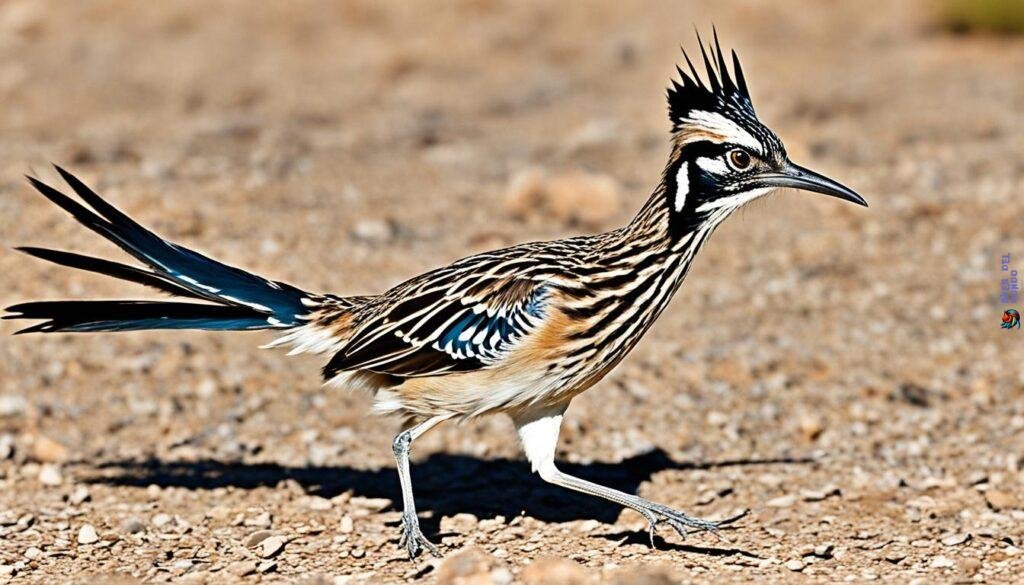
| Adaptations | Description |
|---|---|
| Salt secretion | The Greater Roadrunner secretes a solution of highly concentrated salt through a gland in front of each eye, aiding in water conservation. |
| Gular fluttering | Roadrunners can flutter the unfeathered area beneath their chin, allowing them to dissipate excess heat and regulate their body temperature. |
| Handling venomous prey | Roadrunners have developed specific techniques for handling venomous prey, such as swallowing horned lizards head-first with the horns pointed away from vital organs. |
Behaviors of the Greater Roadrunner
The Greater Roadrunner, known for its impressive running abilities, showcases a range of fascinating behaviors that contribute to its survival and courtship rituals.
Running: As its name suggests, the Greater Roadrunner is adept at running. It zips along roads, streambeds, and paths with astonishing speed, using its strong legs to chase down prey and cover large distances efficiently.
Hunting: Utilizing its running prowess, the Greater Roadrunner employs a variety of hunting techniques. It chases after small animals, including lizards, snakes, mice, and birds, using its agility and speed to catch them. Additionally, the roadrunner can perform impressive jumps to snatch flying insects, bats, and even hummingbirds.
Sunbathing: In the morning, after cold desert nights, the Greater Roadrunner indulges in a unique behavior known as «sunbathing.» It positions itself in a sunny spot, spreading its feathers to absorb sunlight and warm up its body, conserving energy for the day ahead.
Territorial Calls: Male roadrunners are known to defend their territory from atop fence posts and rocks. They emit distinctive, mournful calls that resound through the landscape, with a mournful coo-cooo-coooo sound. These territorial calls serve as a warning to potential intruders and assert their dominance within the area.
Courtship: The Greater Roadrunner forms lifelong partnerships with their mates and engages in elaborate courtship displays. Male roadrunners perform a variety of behaviors to attract females, including bowing, cooing, and flicking their tails. These captivating rituals showcase the commitment and bonding between roadrunner pairs.
Comparing the Behaviors of the Greater Roadrunner
| Behavior | Description |
|---|---|
| Running | Races along roads, streambeds, and paths to hunt prey. |
| Hunting | Chases and catches a diverse range of prey, including lizards, snakes, mice, birds, and even insects in flight. |
| Sunbathing | Warms up its body by basking in the sun, conserving energy. |
| Territorial Calls | Males ward off intruders by vocalizing with their signature coo-cooo-coooo calls. |
| Courtship | Males engage in elaborate displays to attract and bond with their mates. |
Greater Roadrunner’s Predators
While the Greater Roadrunner is a fast and agile bird, it faces predators in its environment that pose challenges to its survival. Let’s explore some of the main predators that the Greater Roadrunner encounters:
Coyotes
One surprising threat to the Greater Roadrunner comes from coyotes. These intelligent canines can reach speeds of up to 43 miles per hour, making them formidable predators. When roadrunners are on the ground, coyotes can pose a significant danger due to their speed and hunting abilities.
Rattlesnakes
Rattlesnakes are another potential danger to the Greater Roadrunner. These venomous snakes are adept at camouflaging themselves in the desert terrain, making them difficult to spot. While roadrunners are known to kill and eat rattlesnakes, they must still exercise caution when dealing with these venomous predators.
Birds of Prey
Birds of prey, such as hawks and owls, are also potential predators of the Greater Roadrunner. These aerial hunters have keen eyesight and powerful talons, making them a significant threat to roadrunners. The roadrunners’ relatively large size and distinctive appearance can attract the attention of these predatory birds.
Despite these risks, the Greater Roadrunner has developed various adaptations and defensive behaviors to increase its chances of survival. These adaptations enable roadrunners to navigate their environment and avoid predation from their natural foes.
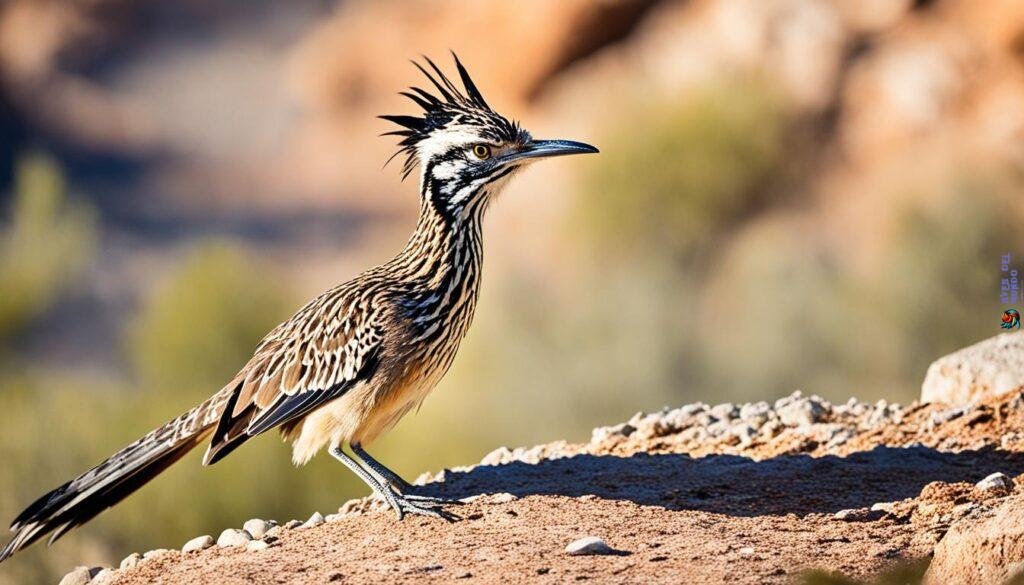
Conservation of the Greater Roadrunner
The Greater Roadrunner, with its unique characteristics and habitat, is considered a species of low conservation concern. Its population remains stable, and breeding populations have even experienced slight increases in recent years. However, the species still faces several threats that need careful attention to ensure its long-term survival.
Habitat loss due to development and fragmentation is one of the major concerns for the conservation of Greater Roadrunners.
The expansion of human activities and urbanization pose significant challenges to the roadrunner’s natural habitat. As their territories shrink and become fragmented, roadrunners struggle to find suitable areas for breeding, foraging, and nesting. This loss of habitat affects their overall population and poses a risk to the species.
Additionally, illegal shooting is a significant threat that the Greater Roadrunner faces. Due to misconceptions and mistaken beliefs, roadrunners are sometimes targeted and shot illegally. These actions are often based on the false assumption that roadrunners threaten game bird populations. However, these birds play a vital role in their ecosystems and do not pose a significant risk to other species.
Conservation efforts aim to protect the habitats of the Greater Roadrunner and raise awareness about the importance of preserving these unique birds.
To ensure the conservation of the Greater Roadrunner, emphasis is placed on preserving their habitats and promoting sustainable practices that minimize habitat loss and fragmentation. Efforts include creating protected areas, establishing wildlife corridors, and implementing land management strategies that consider the needs of roadrunners and other wildlife.
Furthermore, raising public awareness about the significance and ecological value of Greater Roadrunners is crucial. Education campaigns, community engagement, and targeted outreach programs can help dispel misconceptions and foster a deeper appreciation for these fascinating birds. By valuing the Greater Roadrunner’s role in the ecosystem, individuals and communities can actively contribute to their conservation.
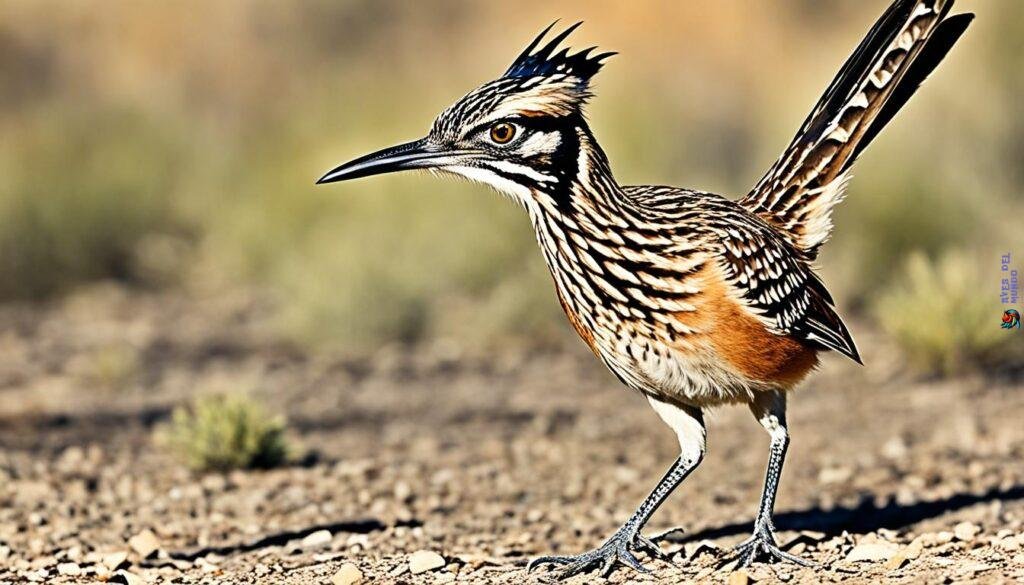
Image of a Greater Roadrunner: A visual representation of the bird species being discussed in this section.
Cultural Significance of the Greater Roadrunner
The Greater Roadrunner holds a special place in Native American and Mexican legends and belief systems. In these cultures, roadrunners are revered for their courage, strength, speed, and endurance. The bird’s X-shaped footprint is considered a sacred symbol used by Pueblo tribes to ward off evil spirits. The X shape hides the direction the bird is heading, preventing evil spirits from following. This cultural significance further highlights the captivating nature of the Greater Roadrunner.
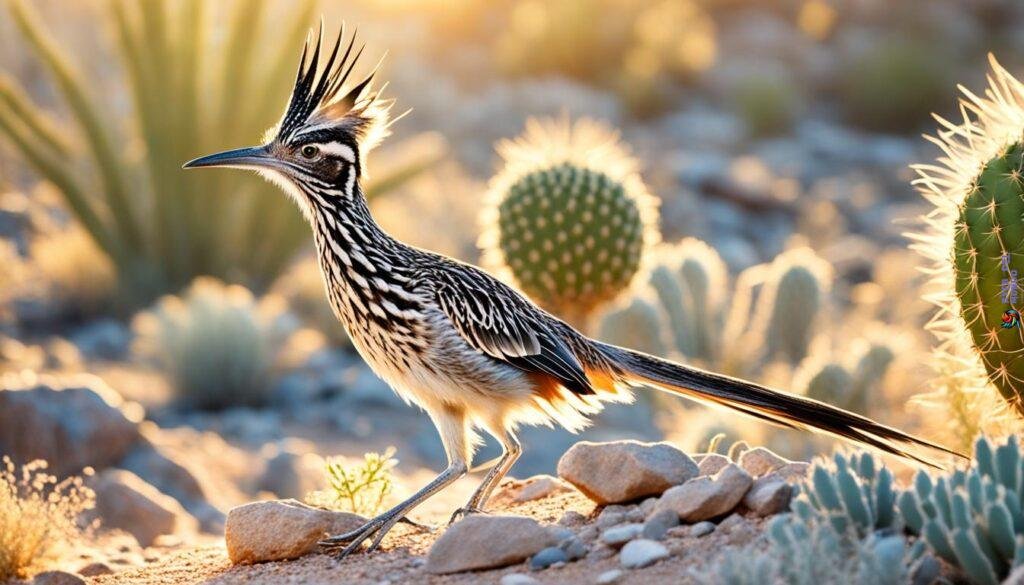
Range Expansion of the Greater Roadrunner
The range of the Greater Roadrunner has expanded beyond its traditional Southwest habitat. These birds can now be found in states such as Missouri, Arkansas, Oklahoma, and Louisiana. This range expansion provides new opportunities for observation and research as scientists monitor the species’ ability to adapt to different environments and climates.
The Greater Roadrunner, known for its incredible speed and unique adaptations, is extending its territory beyond the Sonoran Desert. Previously limited to the arid landscapes of the Southwest, these birds are now making their presence known in states further east.
The expansion of the Greater Roadrunner’s range has piqued the interest of researchers and bird enthusiasts alike. By studying the behavior and ecology of roadrunners in these new areas, scientists can gain valuable insights into how the species adapts to different habitats and climate conditions.
Observing the Greater Roadrunner in Missouri, Arkansas, Oklahoma, and Louisiana allows researchers to compare their behaviors and habits in these new environments to those of their counterparts in the Southwest. This range expansion presents a unique opportunity to study the roadrunner’s ability to thrive in diverse ecosystems.
The expansion of the Greater Roadrunner’s range also opens up new possibilities for birdwatchers and nature enthusiasts. People in these states now have the chance to observe and appreciate the fascinating behaviors and unique characteristics of these iconic birds.
As the Greater Roadrunner continues to expand its range, it will be important to monitor and protect its populations. Conservation efforts should focus on preserving suitable habitats, addressing potential threats, and raising awareness about the significance of this range expansion.
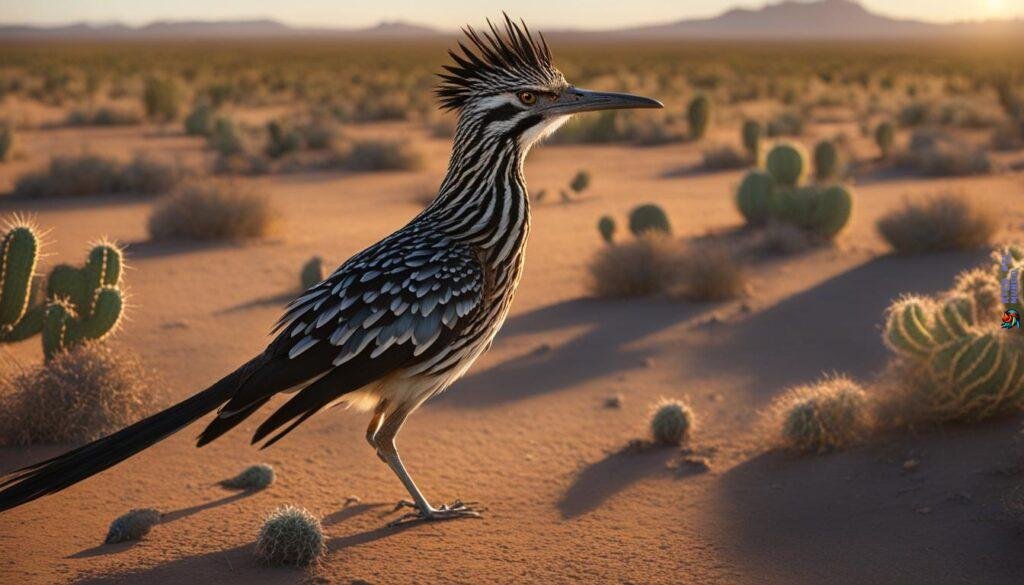
Range Expansion Highlights:
- The Greater Roadrunner’s range has extended beyond the Southwest.
- States such as Missouri, Arkansas, Oklahoma, and Louisiana now see roadrunner populations.
- Scientists are studying the roadrunner’s ability to adapt to different environments and climates in these new areas.
- Observing roadrunners in these states provides new insights into their behavior and ecology.
- The expansion of the roadrunner’s range offers new opportunities for birdwatchers and nature enthusiasts.
- Conservation efforts should aim to protect and preserve roadrunner populations in their expanding range.
Threats to the Greater Roadrunner
The Greater Roadrunner, despite its impressive adaptability, faces a range of threats that pose risks to its population and survival.
1. Severe Winters
The Greater Roadrunner’s range expansion can be limited by severe winters, leading to population declines in certain areas. Harsh cold temperatures and reduced food availability can hinder the bird’s ability to thrive and reproduce.
2. Habitat Loss
One of the greatest threats to the Greater Roadrunner is habitat loss due to development and urbanization. As natural habitats are fragmented and destroyed, the bird’s territories shrink, essential resources become scarce, and nesting sites are compromised.
3. Predators
The Greater Roadrunner faces predation from various predators in its environment. Coyotes, known for their agility and speed, can pose a significant threat to roadrunners. Additionally, rattlesnakes and certain birds of prey target roadrunners as prey, further endangering their population.
These threats underscore the need for conservation efforts focused on preserving suitable habitats, mitigating habitat loss, and raising awareness about the importance of protecting the Greater Roadrunner and its unique ecological role.
| Threats to the Greater Roadrunner | Impact |
|---|---|
| Severe Winters | Population declines in certain areas due to limited range expansion and reduced food availability. |
| Habitat Loss | Fragmentation of habitats, shrinking territories, and scarcity of essential resources. |
| Predators | Threat from coyotes, rattlesnakes, and birds of prey targeting roadrunners as prey. |
Concerted efforts are necessary to address these threats, ensuring the long-term survival of this remarkable bird species. By safeguarding their habitats and protecting them from potential predators, we can secure a future for the Greater Roadrunner where it can continue to flourish and thrive.
Breeding and Nesting Behavior of the Greater Roadrunner
The Greater Roadrunner exhibits fascinating breeding and nesting behavior. When it comes to nest site selection, the pair shows a preference for locations that are typically 3-10 feet off the ground. They choose horizontal branches or the crotch of sturdy bushes, cacti, or small trees. Their nesting sites are shaded and well-concealed, often found near paths or streambeds.
The male roadrunner takes on the responsibility of gathering twigs, which the female skillfully fashions into a compact platform with a nest cup. The completed nest can reach over 17 inches in diameter, providing ample space for the eggs and future young. It’s fascinating to note that roadrunners may reuse nests from previous years, making modifications as needed.
The nest is lined with a variety of materials to create a comfortable environment for the eggs and chicks. The lining materials include leaves, grasses, feathers, snakeskin, and even dung flakes. This assortment of materials offers insulation and protection for the eggs and nesting young.
Female roadrunners typically lay 2-6 eggs per clutch, which are carefully incubated by both parents. The incubation period lasts approximately 19-20 days, during which the parents take turns keeping the eggs warm and safe. As the chicks grow, the parents continue to build up the sides of the nest to accommodate their changing size.

The incubation and growth of Greater Roadrunner chicks are truly remarkable. Once hatched, the chicks are vigorous and active, with closed eyes, black skin, and white down along their feather tracts. Their parents diligently provide them with food, supporting their rapid growth and development. This reproductive process plays a crucial role in the long-term survival of the species.
Incubation and Growth of Greater Roadrunner Chicks
Once the female Greater Roadrunner lays her eggs, both parents take turns incubating them for about 19-20 days. This shared responsibility ensures the proper development of the embryos and allows the parents to support each other in the demanding task of nurturing their offspring.
During the incubation period, the roadrunner parents continue to work on the nest, reinforcing and building up the sides as the chicks grow. This nest-building activity helps create a secure and comfortable environment for the developing chicks.
When the eggs hatch, the chicks emerge with closed eyes but are strong and active. Their bodies are protected by black skin, and they are covered in a soft coat of white down along their feather tracts. This downy plumage provides insulation and helps regulate the chicks’ body temperature.
Roadrunner parents play a vital role in the growth of their chicks. They diligently provide them with food, primarily insects and small prey, ensuring their proper nutrition and development. The young birds grow rapidly under the attentive care of their parents, acquiring the strength and skills necessary for survival in their harsh desert habitat.
As the chicks mature, eventually they will leave the nest and begin to explore their surroundings under the watchful eye of their parents. This process of incubation, growth, and fledging is essential for the long-term survival of the greater roadrunner species.
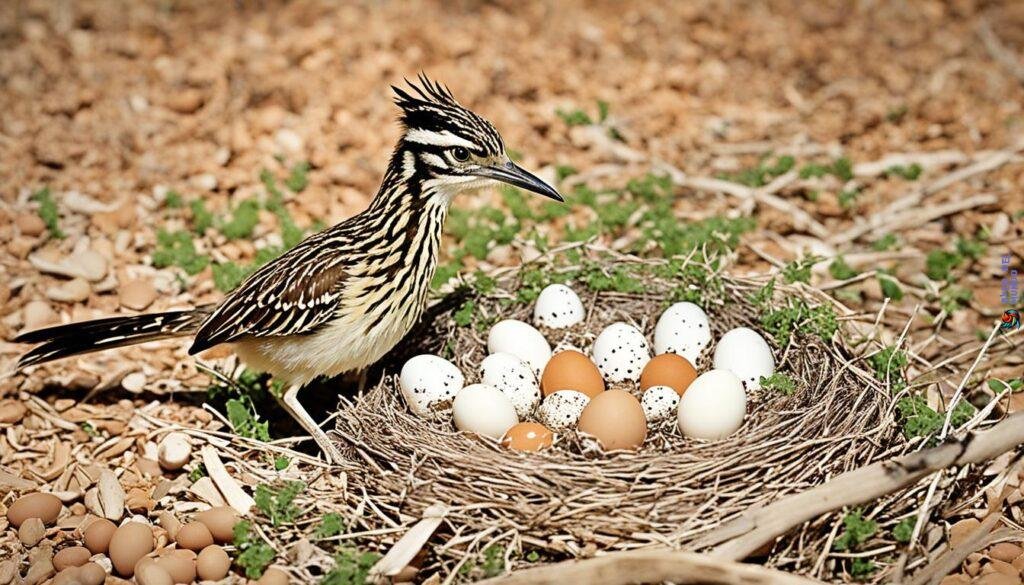
Greater Roadrunner Vocalizations and Communication
The Greater Roadrunner, an iconic bird of the Sonoran Desert, utilizes a range of vocalizations to communicate with other members of its species. These unique calls serve various purposes, from territorial displays to courtship rituals.
When it comes to establishing territorial boundaries, male roadrunners take up prominent positions, perching atop fence posts and rocks. From these elevated vantage points, they emit a distinct call that reverberates through the arid landscape: coo-cooo-coooo. This vocalization serves as an auditory declaration, ensuring other roadrunners are aware of their territorial presence.
During courtship, male roadrunners engage in elaborate displays to attract mates. These displays involve a combination of vocalizations, body movements, and distinctive behaviors. As part of the courtship ritual, males may bow, coo, and flick their tails in a synchronized manner. These captivating performances highlight their vigor and suitability as potential mates, captivating the attention of female roadrunners.
The vocalizations and behaviors exhibited by Greater Roadrunners play a crucial role in establishing and maintaining social bonds within their community. From asserting territorial boundaries to securing reproductive success, these communication strategies ensure effective interaction among roadrunners.

Vocalization Examples:
| Vocalization | Purpose |
|---|---|
| coo-cooo-coooo | Marking territorial boundaries |
| Various cooing sounds | Courtship and mate attraction |
| Other chirps and calls | Communication within social groups |
Through vocalizations and nonverbal communication, Greater Roadrunners establish social structures, navigate their environment, and ensure their continued existence in the unique ecosystem of the Sonoran Desert.
Fascination and Research on the Greater Roadrunner
The Greater Roadrunner has captivated researchers and bird enthusiasts alike. Its unique adaptations, behaviors, and interactions with its environment have sparked interest in various scientific studies. Researchers focus on understanding the roadrunner’s diet, behaviors, and habitat preferences to aid conservation efforts. They also utilize advanced techniques such as satellite tracking to track roadrunner movements and gain insights into their ecological role.
One area of research that has intrigued scientists is the Greater Roadrunner’s diverse diet. Studies have revealed that these birds are versatile eaters, consuming a range of prey including small mammals, reptiles, frogs, toads, insects, centipedes, scorpions, and even birds. In winter, they incorporate fruits, seeds, and other plant material into their diet. Understanding their dietary habits helps conservationists ensure that the roadrunner’s ecosystem remains intact, with sufficient food sources.
Behavioral studies have also shed light on the unique behaviors displayed by Greater Roadrunners. Their incredible running speed has been extensively studied, with researchers fascinated by their ability to race along roads, streambeds, and paths while hunting. Roadrunners are also known for their territorial calls, which help establish boundaries and communicate with other birds. These studies contribute to a better understanding of how roadrunners interact with their environment and other species.
Conservation efforts for the Greater Roadrunner heavily rely on research findings. By determining the roadrunner’s habitat preferences and range, researchers can identify priority areas for conservation and work towards preserving these important habitats. They also examine the impact of human activities, such as habitat loss and illegal shooting, on roadrunner populations. Through research, conservationists can implement strategies to mitigate these threats and promote the long-term survival of the Greater Roadrunner.
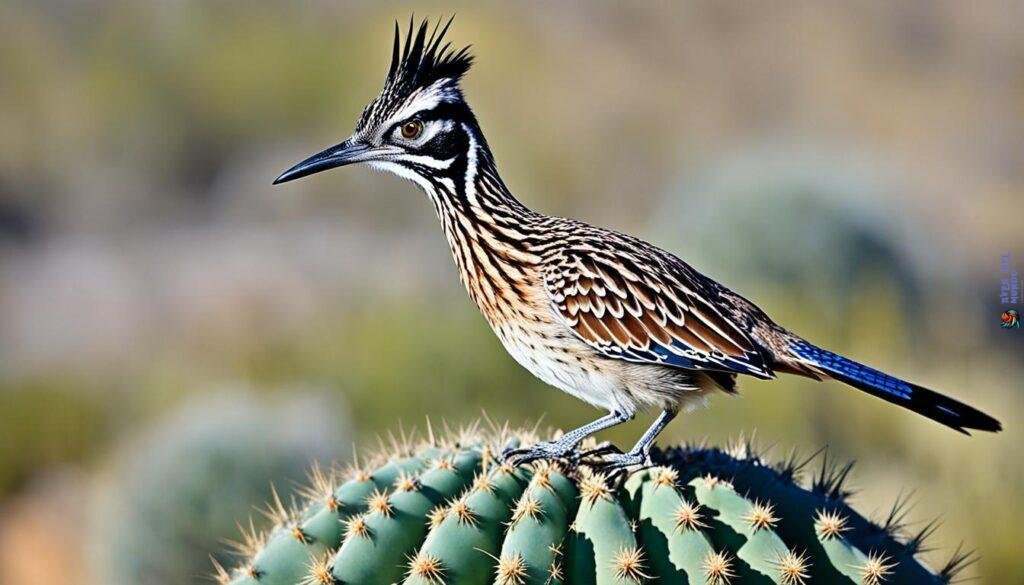
Conclusion: Appreciating the Greater Roadrunner’s Unique Qualities
The Greater Roadrunner is a truly remarkable bird that has captivated people around the world with its unique qualities. Not only does it possess the ability to thrive in the harsh conditions of the Sonoran Desert, but it also boasts incredible speed and a diverse diet. This bird’s adaptability and resilience are a testament to its remarkable nature.
By appreciating the Greater Roadrunner, we gain a deeper understanding of the importance of preserving its habitat and protecting this species for future generations. The Sonoran Desert, with its arid and challenging environment, provides a home for this extraordinary bird. Its ability to navigate through the desert’s shrubs and open country showcases the Greater Roadrunner’s resourcefulness.
Furthermore, the Greater Roadrunner’s diverse diet, which includes small mammals, reptiles, insects, and even venomous prey, demonstrates its versatility as a predator. This bird’s ability to consume a wide range of food sources highlights its crucial role in maintaining the delicate balance of the Sonoran Desert ecosystem.
Appreciating and studying the greater roadrunner allows us to delve deeper into the wonders of nature and gain a newfound appreciation for the incredible diversity that exists within our planet. By preserving the unique qualities of the Greater Roadrunner and its Sonoran Desert habitat, we can ensure the continued survival of this fascinating species for generations to come.



